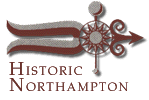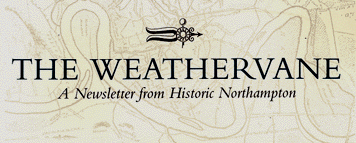

|


Weathervane Newsletter Fall 1996

In the Days of '49: Missing Chapter of Starkweather Saga Surfaces in Bequest to Historic Northampton
In February of 1849, Charles Starkweather left Northampton to set sail for the gold fields of California with the Holyoke Mining Company. Six months later he arrived in San Francisco. Eventually, his brothers Alfred and Haynes joined him.
Their odyssey in California is chronicled in a 1982 article in the Pacific Historian based on a collection of Starkweather letters in the Huntington Library. Like many who came for gold in 1849, the Starkweather brothers found less tangible, but perhaps equally compelling reasons to linger in California. The "splendid, glorious climate" was, no doubt, alluring, but Haynes Starkweather found that "the contrast & ways of living is no less." The "free & easy, mind your own business way of doing things," he observed, "is certainly most pleasant." Charles eventually returned to Northampton where his son married Lucy Williston in 1894. His brothers, after returning east for a period, settled permanently in California. Their letters, spanning three decades, convey the texture of everyday experience in the lives of those who took part in the early settlement of the American West.
There were gaps in the story, however, but the missing chapters in the Starkweather saga surfaced unexpectedly last winter when Historic Northampton received a bequest from the estate of Agnes Wright Howland, a descendent of one of Northampton's earliest settlers. Among the items bequeathed was a packet of 41 letters dated from 1849 to 1857. Most of the letters are from Charles G. Starkweather to members of his family in Northampton who, at that time, lived in the Lyman Road, Fort Hill area.
These letters begin with Charles Starkweather's departure from Boston in February, 1849, and chronicle the weeks at sea with ports of call at St. Thomas where Starkweather's keen sense of observation gives us a vivid picture of a recently emancipated population of former slaves. The letters take a dramatic turn when the party reaches Panama. The arduous overland journey through swamp and mosquito infested jungle a half century before Teddy Roosevelt dug his canal was difficult enough. But when the party reached the Pacific, its arrangements for transportation to California had fallen through and Starkweather had to wait months before another ship could be secured, outfitted and manned.
By the fall of 1849, Starkweather had reached California where he joined the growing ranks of prospectors in the hills above the Sacramento River. His letters recount his day-to-day experiences as he searched for gold along the streams and riverbeds and offer a glimpse of the colorful personalities he encountered along the way. Here is Starkweather's account of a chance encounter with John Sutter, whose legendary discovery sparked the gold rush of 1849:
...we had the luck to meet Capt Suter [Sic] near the door, who gave us a gentlemanly invitation to enter his private apartment and warm and refresh ourselves, also presenting us an agreeable cordial in which we had the pleasure of drinking to his health.... Capt Suter called our attention to some curiosities he had. The sides of his room are hung around with a variety, several cases of insects put up with taste, fancy articles of Indian skill, some beautiful paintings, a pair of pistols of ancient origin, costly, beautifully wrought with gold. My attention was caught by the portrait of a fine looking lady & not American, nor dressed in very modern style which was that of his wife, whom he had not seen for eighteen years, and what is more interesting, he expects to meet her upon the arrival of the next steamer from Panama. The company partook at his urgent request of the refreshments presented, and then proceeded down to Nicholas Banedu, who is another Dutch Man, where we spent the night laying our blankets upon the ground floor making ourselves as comfortable as circumstances admitted.
Contents Historic Northampton.